key CHEVROLET TRACKER 1994 Owners Manual
[x] Cancel search | Manufacturer: CHEVROLET, Model Year: 1994, Model line: TRACKER, Model: CHEVROLET TRACKER 1994Pages: 258, PDF Size: 14.43 MB
Page 20 of 258
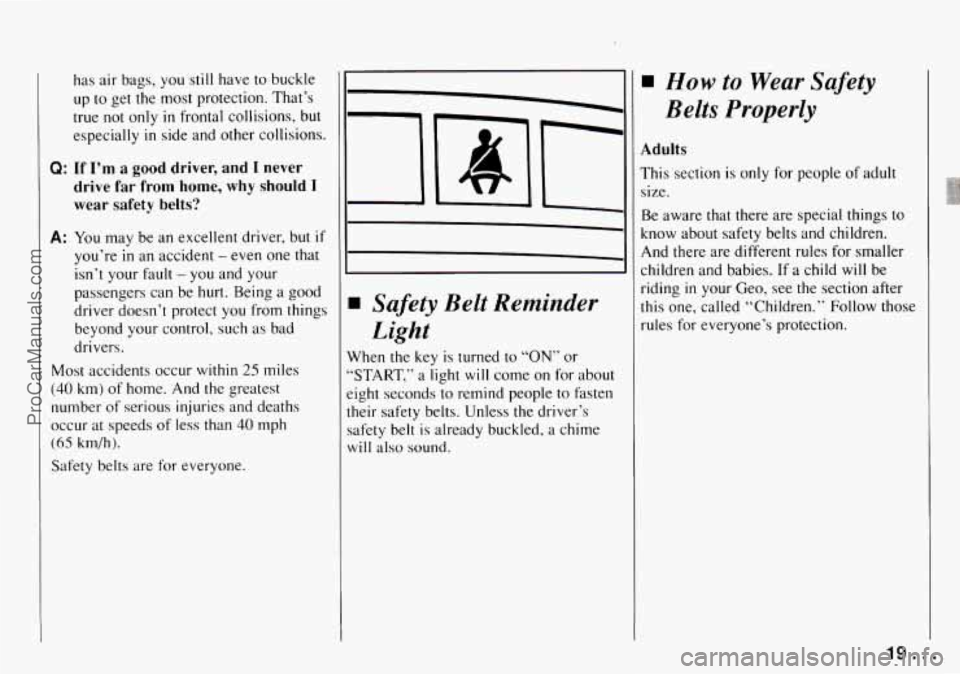
has air bags, you still have to buckle
up to get the most protection. That’s
true not only
in frontal collisions, but
especially
in side and other collisions.
Q: If I’m a good driver, and I never
drive far from home, why should
I
wear safety belts?
A: You may be an excellent driver, but if
you’re in an accident - even one that
isn’t your
fmlt - you and your
passengers can be
hurt. Being a good
driver doesn’t protect you from things
beyond your control, such as bad
drivers.
Most accidents occur within 25 miles
(40 km) of home. And the greatest
number
of serious injuries and deaths
occur at speeds
of less than 40 mph
(65 km/h).
Safety belts are for everyone.
w How to Wear Safety
Belts Properly
Adults
This section is only for people of adult
size.
Be aware that there are special things to
know about safety belts and children.
And there are different rules for smaller
children and babies.
If a child will be
riding
in your Geo, see the section after
this one, called “Children.”
Follow those
rules for everyone’s protection. Safety Belt Reminder
Light
Nhen the key is turned to “ON” or
‘START,” a light will come on for about
:ight seconds
to remind people to fxten
heir safety belts. Unless the driver’s
afety belt is already buckled, a chime
vill also sound.
19 ...
ProCarManuals.com
Page 24 of 258

To unlatch the belt, just push the button
on the buckle. The belt should go back
out of the way.
Before you close
the door, be sure the belt
is out of the way. If you slam the door on
it, you can damage both the belt and your
vehicle.
Safety Belt Use during Pregnancy
Safety belts work for everyone, including
pregnant women. Like all occupants, they
are more likely to be seriously injured if
they don’t wear safety belts.
A pregnant woman should wear a
lap-shoulder belt, and
the lap portion
should be worn as low as possible
throughout the pregnancy.
The best way to protect the fetus is to
protect the mother. When a safety belt
is
worn properly, it’s more likely that the
fetus won’t be hurt in a crash. For
pregnant women, as for anyone, the key
to making safety belts effective is wearing
them properly.
L
1
Passenger Positions
Right Front Passenger Position
The right front passenger’s safety belt
works the same way as
the driver’s safety
belt. See “Driver Position,’’ earlier in this
part.
When the shoulder belt is pulled out all
the way, it will lock.
If it does, let it go
back all the way and start again.
23. ..
ProCarManuals.com
Page 36 of 258
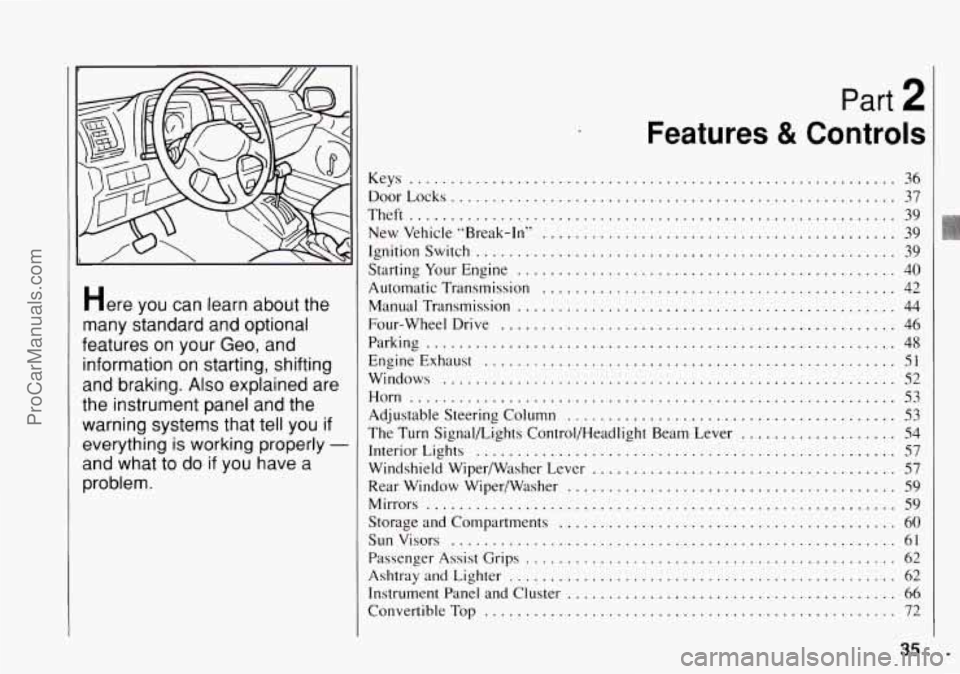
Here you can learn about the
many standard and optional
features on your Geo. and
information on starting. shifting
and braking
. Also explained are
the instrument panel and the
warning systems that tell you
if
everything is working properly -
and what to do if you have a
problem
.
Part 2
Features & Controls
Keys ........................................................... 36
DoorLocks ...................................................... 37
Theft
........................................................... 39
New Vehicle “Break-In” ........................................... 39
Ignitionswitch ................................................... 39
Starting
Your Engine .............................................. 40
Automatic Transmission ................. ...................... 42
Manual Transmission
............... ...................... 44
Four-wheel Drive ................................................ 46
Parking ......................................................... 48
EngineExhaust
.................................................. 51
Windows ....................................................... 52
Horn
........................................................... 53
Adjustable Steering Column ........................................ 53
Interior Lights
................................................... 57
Windshield WiperjWasher Lever
..................................... 57
Rear Window Wiperwasher
........................................ 59
Mirrors ......................................................... 59
Storage and Compartments
....................................... 60
Sun Visors
................................... .. ..... 61
Passenger Assist Grips
............................................. 62
Ashtray and Lighter
............................................... 62
Instrument Panel and Cluster
........................................ 66
The Turn Signalbights Control/Headlight Beam Lever ................... 54
ConvertibleTop
.................................................. 72
35 I ..
ProCarManuals.com
Page 37 of 258

Features and Controls
Keys
-
c
d
F
d
k
1
Y
tc
S
b
U
)ne key is used for the ignition, the
.oors, and all other locks.
Yhen a new Tracker is delivered, the
ealer removes
the metal plate from the
.ey ring and gives
it to the first owner.
'he metal plate has a code on it that tells
'our dealer or a qualified locksmith
how
3 make extra keys. Keep the code in a
afe place. If you lose your keys, you'll
le able to have new ones made easily
sing this code.
NOTICE:
Your Geo has a number of features
that can help prevent theft. But
you
can have a lot of trouble getting into
your vehicle if you ever lock your
keys inside.
You may even have to
damage your vehicle
to get in. So be
sure
you have an extra key.
... 36
ProCarManuals.com
Page 38 of 258

Door Locks
There are several ways to lock and unlock
your vehicle:
From the outside, use your key. To lock
the door,
turn the key toward the front of
the vehicle.
To unlock the door, turn the
key toward the rear.
/
To lock the door from the inside, push
down the button on the door.
To unlock it,
pull up on the button.
Leaving Your Vehicle
If you are leaving the vehicle, take your
key, open your door and set the
locks
from inside. Then get out and close the
door.
37 ...
ProCarManuals.com
Page 39 of 258

Features and Controls
Tailgate
Use your key to lock or unlock your
tailgate.
If you have a convertible, be sure to unzil
the rear plastic window completely
befort
opening the tailgate. See "Opening and
Closing Your Rear Window"
in the Index
Open
the tailgate with the bottom of the
window still
altached to the tailgate.
When closing the tailgate be sure:
e
0
Both lower canvas top flaps are facini
outward
so they do not get caught in
the tailgate.
The zipper connector
is engaged
correctly or
you could damage your
zipper.
... 38
ProCarManuals.com
Page 40 of 258
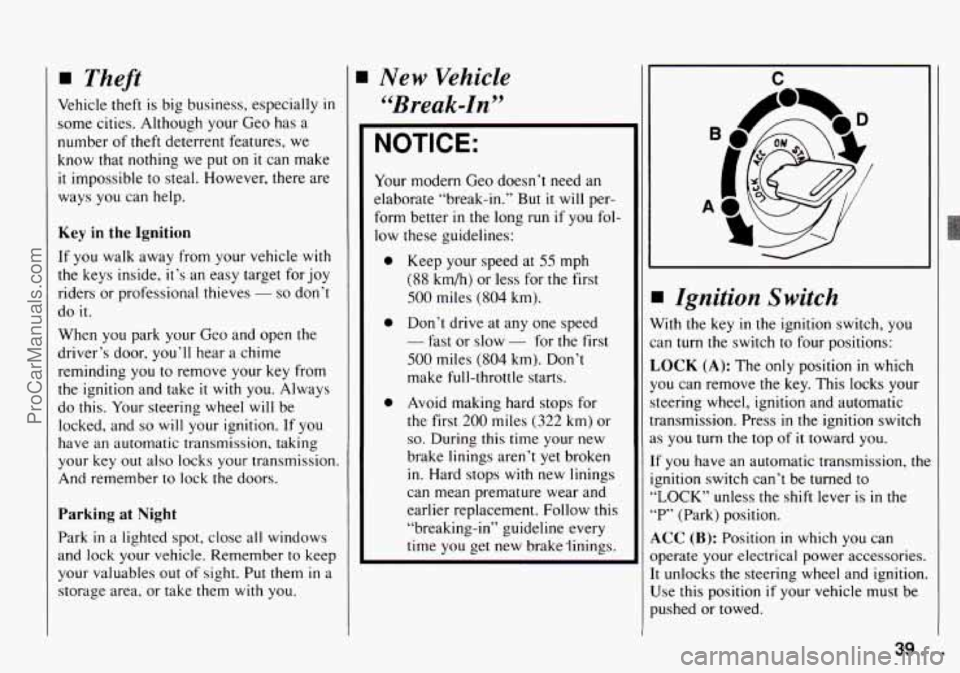
Theft
Vehicle theft is big business, especially in
some cities. Although your Geo has a
number of theft deterrent features, we
know that nothing we
put on it can make
it impossible to steal. However, there are
ways you can help.
Key in the Ignition
If you walk away from your vehicle with
the keys inside, it’s an easy target for joy
riders or professional thieves
- so don’t
do
it.
When you park your Geo and open the
driver’s door, you’ll hear a chime
reminding you to remove your key from
the ignition and take
it with you. Always
do this. Your steering wheel will be
locked, and
so will your ignition. If you
have
an automatic transmission, taking
your key out
also locks your transmission.
And remember to lock the doors.
Parking at Night
Park in a lighted spot, close all windows
and lock your vehicle. Remember
to keep
your valuables out
of sight. Put them in a
storage area, or take them with you.
New Vehicle
"Break-in"
NOTICE:
Your modern Geo doesn‘t need an
elaborate “break-in.” But
it will per-
form better
in the long run if you fol-
low these guidelines:
0 Keep your speed at 55 mph
(88 km/h) or less for the first
500 miles (804 km).
0 Don’t drive at any one speed
- fast or slow - for the first
500 miles (804 km). Don’t
make full-throttle starts.
0 Avoid making hard stops for
the first
200 miles (322 km) or
so. During this time your new
brake linings aren’t yet broken
in. Hard stops
with new linings
can mean premature wear and
earlier replacement. Follow this
“breaking-in“ guideline every
time you get new brake linings.
C
I Ignition Switch
Vith the key in the ignition switch, you
an
turn the switch to four positions:
,OCK (A): The only position in which
‘ou can remove the key. This locks your
teering wheel, ignition and automatic
ransmission. Press
in the ignition switch
s you turn the top of it toward you.
f you have an automatic transmission, the
gnition switch can’t be turned
to
,LOCK” unless the shift lever is in the
‘P’ (Park) position.
LCC (B): Position in which you can
bperate your electrical power accessories.
t unlocks the steering wheel and ignition.
Jse this position
if your vehicle must be
mhed or towed.
39. .
ProCarManuals.com
Page 41 of 258
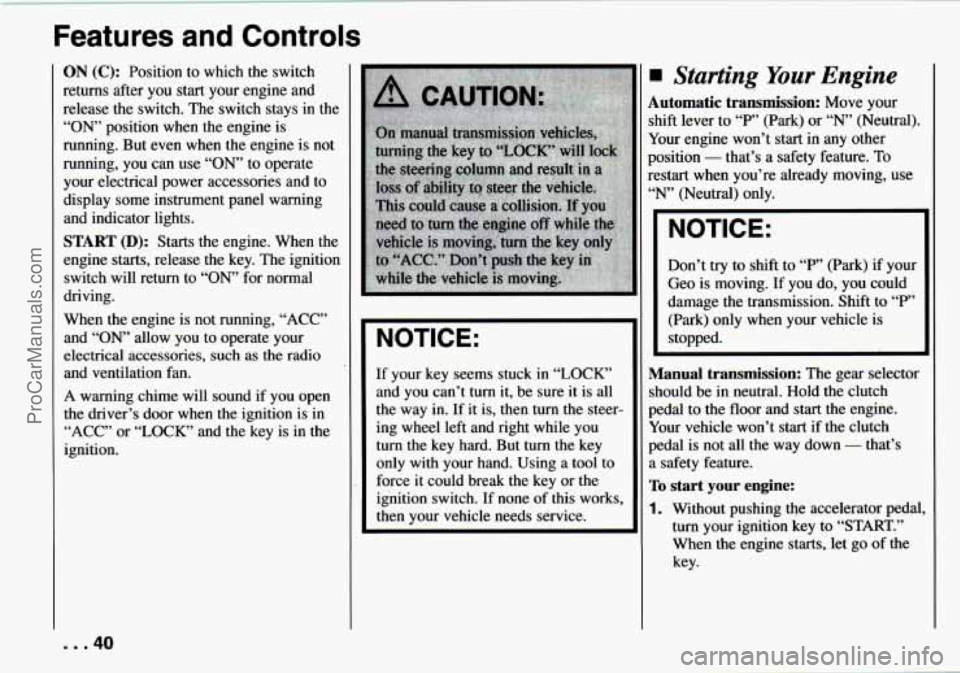
Features and Controls
ON (C): Position to which the switch
returns after
you start your engine and
release the switch. The switch stays in the
“ON’ position when the engine is
running. But even when the engine is not
running, you can use
“ON’ to operate
your electrical power accessories and to
display some instrument panel warning
and indicator lights.
START (D): Starts the engine. When the
engine starts, release the key. The ignition
switch will return to
“ON’ for normal
driving.
When the engine is not running, “ACC”
and
“ON’ allow you to operate your
electrical accessories, such as the radio
and ventilation fan.
A warning chime will sound if you open
the driver’s door when the ignition is in
“ACC” or “LOCK” and the key is in the
ignition.
NOTICE:
If your key seems stuck in “LOCK”
and you can’t
turn it, be sure it is all
the way in. If it is, then turn the steer-
ing wheel left and right while you
turn the key hard. But turn the key
only with your hand. Using a tool to
force it could break the key or the
ignition switch. If none of this works,
then your vehicle needs service.
Starting Your Engine
Automatic transmission: Move your
shift lever to
“P” (Park) or “N’ (Neutral).
Your engine won’t start in any other
position
- that’s a safety feature. To
restart when you’re already moving, use
“N’ (Neutral) only.
NOTICE:
Don’t try to shift to “P’ (Park) if your
Geo is moving.
If you do, you could
damage the transmission. Shift to
“P”
(Park) only when your vehicle is
stopped.
Manual transmission: The gear selector
should be in neutral. Hold the clutch
pedal to the floor and start the engine.
Your vehicle won’t start if the clutch
pedal is
not all the way down - that’s
a safety feature.
To start your engine:
1. Without pushing the accelerator pedal,
turn your ignition key
to “START.”
When the engine starts, let
go of the
key.
... 40
ProCarManuals.com
Page 42 of 258

NOTICE:
Holding your key in “START” for
longer than 15 seconds at a time will
cause your battery to be drained
much sooner. And the excessive heat
can damage your starter motor.
2. If it doesn’t start right away, hold
your key
in “ START” for about three
seconds at a time until your engine
starts. Wait about 15 seconds between
each
try to help avoid draining your
battery.
If your engine still won’t start, call your
dealer for help.
NOTICE:
Your engine is designed to work with
the electronics in your vehicle. If you
add electrical parts or accessories,
you could change the way
the fuel
injection system operates. Before
adding electrical equipment, check
with your dealer. If you don’t, your
engine might not perform properly.
If you ever have to have your vehicle
towed, see the part of this manual
that tells how to do
it without damag-
ing your vehicle. See “Towing Your
Vehicle” in the Index.
)riving through Deep Standing
Water Engine Coolant Heater (Engine
Block Heatel‘) (CANADA)
In very
cold weather, 0 OF (- 1 8 O C) or
colder, the engine coolant heater can help.
You’ll get easier starting and better fuel
economy during engine warm-up.
Usually, the coolant heater should be
plugged in a minimum
of four hours
prior to starting your vehicle.
To use the coolant heater:
1. Turn off the engine.
2. Open the hood and unwrap the
electrical cord.
3. Plug it into a normal, grounded
110-volt outlet.
NOTICE:
If you drive too quickly through deep
puddles
or standing water, water can
come in through your engine’s air
intake and badly damage your
engine.
If you can’t avoid deep
puddles or standing water, drive
through them very slowly.
41 ..
ProCarManuals.com
Page 44 of 258
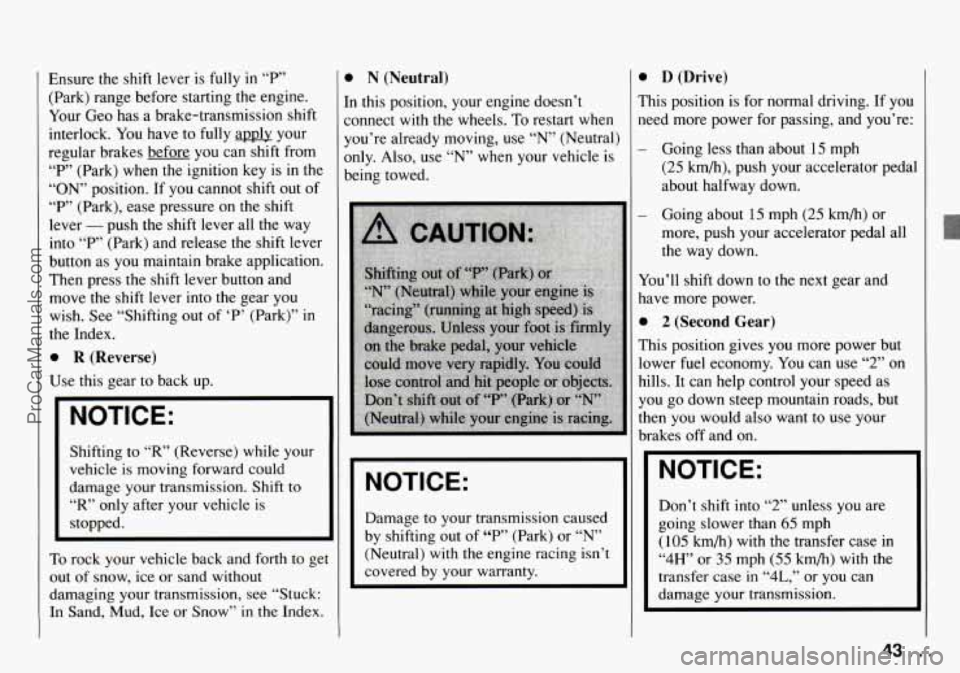
Ensure the shift lever is fully in “F‘”
(Park) range before starting the engine.
Your Geo has a brake-transmission shift
interlock.
You have to fully apply your
regular brakes before you can shift from
“P” (Park) when the ignition key is in the
“ON’ position. If you cannot shift out of
“P’ (Park), ease pressure on the shift
lever
- push the shift lever all the way
into
“P’ (Park) and release the shift lever
button as you maintain brake application.
Then press the shift lever button and
move the shift lever into the gear you
wish. See “Shifting out of ‘P’ (Park)”
in
the Index.
0 R (Reverse)
Use this gear to back up.
I NOTICE:
Shifting to “R” (Reverse) while your
vehicle is moving forward could
damage your transmission. Shift to
“R” only after your vehicle is
stopped.
~~
To rock your vehicle back and forth to gel
out of snow, ice or sand without
damaging your transmission, see “Stuck:
In Sand,
Mud, Ice or Snow” in the Index.
t
0 N (Neutral)
In this position, your engine doesn’t
connect with the wheels. To restart when
you’re already moving, use
“N’ (Neutral)
only. Also, use “N” when your vehicle is
being towed.
NOTICE:
Damage to your transmission caused
by shifting out of “P” (Park) or
“N’
(Neutral) with the engine racing isn’t
covered by your warranty.
0 D (Drive)
This position is for normal driving. If you
need more power for passing, and you’re:
- Going less than about 15 mph
(25
km/h), push your accelerator peda
about halfway down.
- Going about 15 mph (25 km/h) or
more, push your accelerator pedal all
the way down.
You’ll shift down to the next gear and
have more power.
0 2 (Second Gear)
This position gives you more power but
lower fuel economy. You can use “2” on
hills.
It can help control your speed as
you go down steep mountain roads, but
then you would also want to use your
brakes off and on.
Don’t shift into “2” unless you are
going slower than
65 mph
( 105 km/h) with the transfer case in
“4H’ or 35 mph (55 km/h) with the
transfer case in “4L,” or you can
damage your transmission.
43.
ProCarManuals.com